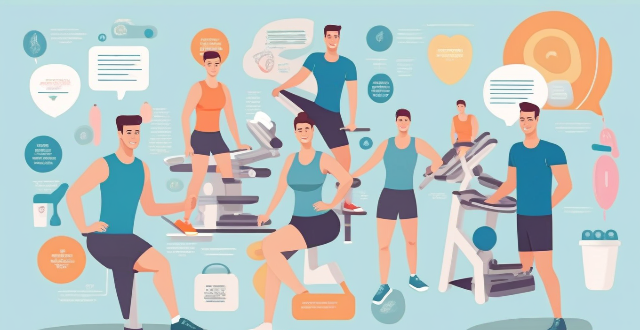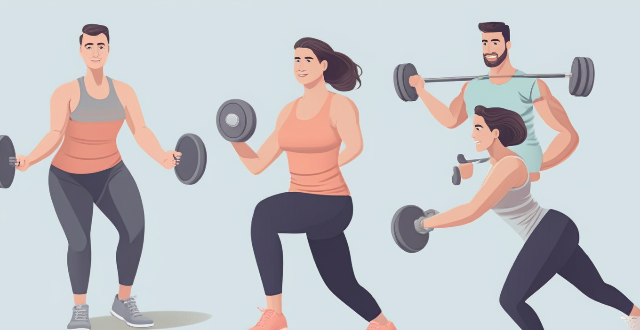Lead Fitness

What are some common mistakes that women make when starting a new fitness plan ?
Starting a new fitness plan can be exciting and daunting at the same time. However, many women make some common mistakes that can hinder their progress and lead to frustration. Here are some of the most common mistakes: 1\. Setting Unrealistic Goals: One of the biggest mistakes women make when starting a new fitness plan is setting unrealistic goals. It's important to set achievable and realistic goals that align with your fitness level, lifestyle, and schedule. 2\. Overtraining: Another common mistake is overtraining. This can lead to fatigue, burnout, and even injury. It's essential to listen to your body and give it enough rest and recovery time between workouts. 3\. Neglecting Nutrition: Many women focus solely on exercise and neglect their nutrition. However, what you eat plays a crucial role in achieving your fitness goals. A balanced diet with adequate protein, healthy fats, and complex carbohydrates is essential for fueling your workouts and promoting muscle growth and recovery. 4\. Not Warming Up or Cooling Down: Skipping warm-up or cool-down exercises can increase the risk of injury and reduce the effectiveness of your workouts. A proper warm-up prepares your body for exercise by increasing blood flow and warming up your muscles, while a cool-down helps your body gradually return to its resting state. 5\. Relying Solely on Cardio: While cardio is an excellent way to burn calories and improve cardiovascular health, relying solely on it can lead to a plateau in weight loss and muscle tone. Incorporating strength training into your fitness plan can help build lean muscle mass, which boosts metabolism and leads to more efficient calorie burning. 6\. Ignoring Pain or Discomfort: Many women push through pain or discomfort during their workouts, thinking it's just part of the process. However, ignoring pain or discomfort can lead to serious injuries that set back your progress significantly. If something doesn't feel right, it's essential to stop and seek professional advice. 7\. Comparing Yourself to Others: Comparing yourself to others can be discouraging and demotivating. Everyone has different bodies, fitness levels, and goals, so it's essential to focus on your own progress rather than comparing yourself to others. Remember that everyone starts somewhere, and consistency and dedication are key to achieving your fitness goals.

Are fitness trackers worth the investment ?
Fitness trackers can provide motivation, data collection, convenience, community support, and customization. However, they also come with potential drawbacks such as cost, inaccuracy, dependency, overemphasis on quantification, and battery life issues. The decision to invest in a fitness tracker should be based on individual needs and priorities.

What certifications should I get as a fitness instructor ?
To become a certified fitness instructor, it's crucial to obtain essential certifications like CPR/AED, personal training, group fitness instruction, and specialty areas of interest. Participating in continuing education will help you stay current and relevant in your field.

How do I choose the right sports equipment for my fitness level ?
When selecting sports equipment, consider your fitness level to avoid injury and maximize workouts. Assess your fitness level (beginner, intermediate, advanced), identify goals (strength training, cardiovascular health, flexibility/balance), and prioritize ease of use, comfort, safety, budget, research, trial before purchase, and space considerations for effective and safe exercise.

Can strength training be part of a female fitness program ?
**Can Strength Training Be Part of a Female Fitness Program?** Yes, strength training is crucial for women's fitness programs. It offers benefits such as improved muscle tone, increased metabolism, enhanced bone density, and reduced injury risk. To integrate strength training effectively: start with light weights, focus on compound movements, balance it with cardio workouts, and consider professional guidance for personalized plans. This approach ensures a comprehensive and beneficial fitness regimen for women.

Can playing sports lead to a sense of accomplishment and pride ?
Playing sports can lead to a sense of accomplishment and pride through physical fitness, teamwork, skill development, and overcoming adversity. Achieving personal fitness goals, collaborating with teammates, mastering sport-specific skills, and bouncing back from challenges all contribute to feelings of satisfaction and self-worth. Engaging in sports is not just about recreation but also about personal growth and development.

What is the role of a fitness instructor in a gym ?
A fitness instructor is responsible for guiding and motivating gym members to achieve their fitness goals. Their roles include designing customized workout plans, providing personal training sessions, leading group fitness classes, educating members on health and fitness topics, and maintaining a clean and safe environment. The ultimate goal of a fitness instructor is to help members reach their fitness objectives and improve their overall health and well-being.

Is there a connection between physical fitness and self-esteem ?
The article discusses the relationship between physical fitness and self-esteem, stating that engaging in regular exercise and maintaining a fit body can improve one's body image, confidence, mental health, and social interaction. In contrast, poor physical fitness can lower self-esteem by negatively impacting body image, confidence, stress levels, and leading to isolation. The author concludes that maintaining good physical fitness is essential for overall well-being and self-esteem.

What are the fitness secrets of celebrity athletes ?
Celebrity athletes maintain their exceptional physical abilities and impressive performances in their respective sports through various fitness strategies, including consistency and discipline, high-intensity training, strength training, proper nutrition, and adequate recovery time. These principles can be applied by anyone looking to improve their fitness level and achieve their goals.

What is the difference between a personal trainer and a fitness instructor ?
The article discusses the differences between a personal trainer and a fitness instructor. Personal trainers design customized workout plans for individual clients, while fitness instructors lead group exercise classes. Personal trainers require certification from accredited organizations like NASM or ACE, while fitness instructors need certification from reputable organizations like AFAA or IDEA. Personal trainers often work in private settings with one-on-one clients, while fitness instructors typically work in public settings leading group classes. Both professions require dedication and continuous learning to stay up-to-date with the latest trends and techniques in the fitness industry.

What are some common mistakes people make when creating a fitness meal plan ?
When creating a fitness meal plan, it's important to avoid common mistakes such as neglecting macronutrient distribution, ignoring micronutrient needs, underestimating calorie needs, overcomplicating meal preparation, and neglecting hydration. To ensure success in achieving health and fitness goals, prioritize balance, simplicity, and sustainability while focusing on meeting individual nutritional needs.

What are the job prospects for fitness instructors ?
The fitness industry is experiencing steady growth, driven byThe fitness industry is experiencing steady growth, driven by of regular exercise, rise in This growth has led to a rise in job opportunities for fitness instructors across various settings such as gyms, corporate wellness programs, community centers, and online platforms. Fitness instructors can also expect career growth through specialization, certification, management, or entrepreneurship. Overall, the job prospects for fitness instructors are promising with numerous opportunities for career advancement.

What kind of training does a fitness instructor need ?
To become a fitness instructor, one needs a high school diploma or equivalent, certification programs like Certified Fitness Instructor (CFI), specialized certifications, practical skills in anatomy, physiology, first aid, teaching and communication. Continuing education is important to stay updated with trends and research. Personal qualities such as passion for health, patience, empathy, leadership, and motivational skills are crucial. Business and marketing skills including client relations management and social media presence are also necessary.

Can you suggest any healthy snack options for my fitness meal plan ?
The text provides a summary of healthy snack options for a fitness meal plan, including fresh fruits, nuts and seeds, Greek yogurt, vegetable sticks with hummus, and whole grain crackers with cheese. It emphasizes the importance of choosing nutritious snacks that contribute to overall fitness goals while satisfying cravings and keeping portion sizes in mind.

How does the misunderstanding of calories in vs. calories out impact fitness goals ?
The misunderstanding of the concept of calories in vs. calories out can significantly impact fitness goals, leading to difficulty in achieving weight loss, muscle loss, and a slower metabolism. It is important to incorporate both a healthy diet and regular physical activity to ensure that more calories are burned than consumed.

Is there a link between physical fitness and cognitive function ?
The text discusses the potential link between physical fitness and cognitive function, citing research that suggests a correlation. It defines physical fitness as the ability to perform aspects of sports or occupations, obtained through proper nutrition, exercise, and rest, and cognitive function as mental processes involving perceiving, remembering, reasoning, problem-solving, understanding, judging, and learning. The text mentions studies that suggest enhanced physical fitness can improve cognitive function in older people without known cognitive impairment and that physical fitness could be a better predictor of cognitive performance than physical activity. It also discusses potential mechanisms behind the relationship, including increased blood flow to the brain and the release of chemicals that promote cell growth, improvement, and survival. Finally, it notes the potential implications of this research for individual and societal health.

How can I improve my teaching skills as a fitness instructor ?
This article provides tips on how to improve teaching skills as a fitness instructor. It suggests developing knowledge of fitness and exercise science, enhancing communication skills, creating engaging workouts, and continuously evaluating and improving teaching methods. The article emphasizes the importance of staying up-to-date with current research and best practices, practicing active listening and empathy, designing well-rounded fitness programs, fostering a supportive community within classes, seeking feedback from clients, and reflecting on one's own performance. By following these tips, fitness instructors can provide higher quality service to their clients and achieve better client outcomes.

What are the best fitness instructor courses available ?
This article provides an overview of the best fitness instructor courses available, including certifications offered by the National Academy of Sports Medicine (NASM), American College of Sports Medicine (ACSM), International Sports Sciences Association (ISSA), Aerobics and Fitness Association of America (AFAA), and Yoga Alliance. The duration, cost, and accreditation of each course are also discussed.

Can sports sponsorship help in promoting health and fitness among the general public ?
Sports sponsorship can promote health and fitness by increasing awareness, providing role models, enhancing accessibility, improving visibility, and offering educational opportunities. However, challenges such as commercialization concerns, equity issues, and sustainability must be addressed to ensure these efforts are equitable and focused on the well-being of all segments of society.

How do sports movies reflect societal attitudes towards health and fitness ?
Sports movies often reflect societal attitudes towards health and fitness, showcasing themes of motivation, teamwork, overcoming adversity, health awareness, and gender equality. These films can inspire viewers to push their limits, work together, persevere through challenges, prioritize their well-being, and support gender equality in sports.

Is it cost-effective for companies to invest in on-site fitness facilities for their workers ?
The text discusses whether it is cost-effective for companies to invest in on-site fitness facilities for their workers. The pros of investing include improved employee health and well-being, attracting and retaining top talent, and increased employee satisfaction and loyalty. However, the cons include high upfront costs, limited use and participation, and maintenance and management challenges. Ultimately, whether it is cost-effective depends on the specific needs and resources of each company.

Is it necessary for employers to provide fitness facilities or subsidize gym memberships ?
As the importance of physical health and wellness becomes increasingly recognized, many employees are looking for ways to maintain an active lifestyle. One option that has gained traction in recent years is for employers to provide fitness facilities or subsidize gym memberships as part of their employee benefits package. Providing fitness facilities or subsidizing gym memberships can help employees stay healthy and energized, which can lead to increased productivity at work. Studies have shown that regular exercise can reduce fatigue, improve mood, and enhance cognitive function, all of which can contribute to better job performance. Offering fitness perks can also be a powerful tool for attracting and retaining top talent. In today's competitive job market, companies need to offer unique benefits that set them apart from their competitors. By providing access to fitness facilities or subsidizing gym memberships, employers can demonstrate a commitment to their employees' well-being and create a positive work culture that fosters loyalty and engagement. While the initial investment in setting up a fitness facility or subsidizing gym memberships may be significant, there are potential long-term cost savings to consider. By promoting a healthy lifestyle among employees, employers may be able to reduce healthcare costs associated with chronic diseases related to poor diet and lack of exercise. Additionally, reducing absenteeism due to illness or injury can also save money in the long run. However, one of the main concerns about providing fitness facilities or subsidizing gym memberships is the cost. Depending on the size of the company and the scope of the program, implementing such benefits can be expensive. Employers must weigh the potential benefits against the financial implications before making any decisions. Another challenge is ensuring that the program is accessible and convenient for all employees. If the company is located in a remote area or has multiple locations, it may not be feasible to provide on-site fitness facilities or subsidize gym memberships at nearby clubs. Additionally, some employees may prefer working out at home or participating in outdoor activities rather than using a gym. Employers must also consider legal issues when implementing fitness programs. For example, they should ensure that any fitness facilities comply with local building codes and safety regulations. They should also be aware of potential liability issues if employees sustain injuries while participating in company-sponsored fitness activities. In conclusion, while it is not absolutely necessary for employers to provide fitness facilities or subsidize gym memberships, doing so can offer several benefits including increased productivity, improved retention and recruitment efforts, and potential cost savings over time. However, employers must carefully consider the financial implications, logistical challenges, and legal considerations before implementing such programs. Ultimately, whether or not to offer these benefits will depend on each individual company's unique circumstances and priorities.

Are there any proven benefits of offering gym memberships or fitness classes as part of workplace wellness programs ?
The text provides a topic summary of the benefits of offering gym memberships or fitness classes as part of workplace wellness programs. It highlights the advantages in terms of improved employee health and well-being, enhanced workplace atmosphere and culture, and financial benefits for employers. The summary also emphasizes that these programs can lead to reduced stress levels, increased energy levels, improved cardiovascular health, increased employee morale, improved teamwork and collaboration, lower absenteeism rates, reduced healthcare costs, increased productivity, and lower turnover rates. Overall, the text suggests that offering gym memberships or fitness classes as part of workplace wellness programs can have numerous benefits for both employees and employers.

Can I take online fitness instructor courses ?
Yes, you can definitely take online fitness instructor courses. In fact, there are many reputable organizations that offer online certification programs for aspiring fitness instructors. Here are some key points to consider: ## Benefits of Online Fitness Instructor Courses 1. **Flexibility**: Online courses allow you to learn at your own pace and on your own schedule. This is especially beneficial for those who have other commitments such as work or family responsibilities. 2. **Cost-effective**: Online courses are often more affordable than traditional in-person training programs. You can save money on travel expenses and accommodation costs. 3. **Wide range of options**: There are numerous online fitness instructor courses available, covering various areas of expertise such as yoga, Pilates, strength training, and more. 4. **Access to expert trainers**: Many online courses are taught by experienced and certified fitness professionals who share their knowledge and expertise through video lectures, interactive quizzes, and practical assignments. 5. **Continuous learning**: Online courses provide an opportunity for continuous learning and development. You can revisit the course materials anytime and stay up-to-date with the latest trends and techniques in the fitness industry. 6. **Career advancement**: Completing an online fitness instructor course can enhance your resume and open up new career opportunities within the fitness industry. ## How to Choose an Online Fitness Instructor Course When selecting an online fitness instructor course, consider the following factors: - **Accreditation**: Ensure that the course is accredited by a reputable organization or institution. This will ensure that the program meets industry standards and provides valuable credentials upon completion. - **Course content**: Check the course outline and make sure it covers all the necessary topics related to fitness instruction, including anatomy, physiology, exercise techniques, programming, and safety guidelines. - **Instructor qualifications**: Look for courses taught by experienced and certified fitness professionals who have a proven track record in the industry. - **Learning resources**: Ensure that the course provides access to high-quality learning resources such as video lectures, e-books, practice exercises, and interactive quizzes. - **Support and feedback**: Choose a course that offers regular support and feedback from instructors or mentors throughout the program. - **Community engagement**: Look for courses that provide opportunities for engagement with other students and fitness professionals through forums, discussion groups, or social media platforms. - **Pricing**: Compare the pricing of different online fitness instructor courses and choose one that fits your budget while offering quality education and resources.

Do fitness trackers accurately monitor sleep patterns ?
The article discusses the accuracy of fitness trackers in monitoring sleep patterns. It explains that while these devices can provide useful information about sleep duration, quality, and stages, their accuracy may vary depending on factors such as device placement, user movement during sleep, and environmental conditions. The article also compares fitness trackers to professional sleep studies conducted by medical professionals and concludes that fitness trackers should not be considered a substitute for these studies.

How can I create a fitness plan specifically for women ?
Creating a fitness plan for women involves understanding their unique physical and physiological needs. Tips include setting realistic goals, incorporating strength training and cardiovascular exercises, considering hormonal cycles, staying hydrated and fueling the body properly, and seeking professional guidance when needed. By following these tips, women can achieve their fitness goals and improve their overall health and well-being.

How long does a lead-acid battery last ?
Lead-acid batteries are commonly used in various applications, including vehicles, uninterruptible power supplies (UPS), and renewable energy storage systems. The lifespan of a lead-acid battery depends on several factors, such as its type, usage, and maintenance. In this article, we will discuss the typical lifespan of lead-acid batteries and provide tips for extending their service life.

How do fitness trackers measure calories burned ?
**How Fitness Trackers Measure Calories Burned: A Comprehensive Overview** Fitness trackers have revolutionized the way we monitor our physical activities and health. One of their most popular features is the ability to estimate the number of calories burned during various exercises. But how do these devices actually calculate this information? In this article, we delve into the science behind fitness trackers and explore the key components that contribute to their calorie-burning estimates. Firstly, heart rate monitoring plays a crucial role. By tracking your heart rate, fitness trackers can gauge the intensity of your workout and, therefore, the approximate number of calories you're burning. Secondly, activity recognition allows the device to identify specific types of movement, such as walking or running, and apply corresponding metabolic equivalent (MET) values to calculate energy expenditure. Thirdly, personal information like age, gender, height, weight, and daily activity level are essential for customizing calorie burn calculations to your unique profile. Finally, sophisticated algorithms combine all these data points to provide an estimate of calories burned. However, it's important to remember that these estimates are not exact measurements but rather approximations based on scientific research and technological advancements. As such, fitness trackers should be viewed as valuable tools to aid in your fitness journey rather than definitive indicators of progress.

What are some good sources of protein for a fitness meal plan ?
Including protein-rich foods like chicken breast, salmon, eggs, Greek yogurt, and quinoa in a fitness meal plan can support muscle building and fat loss goals.

Are there any online fitness programs that are worth trying for home workouts ?
There are several online fitness programs worth trying for home workouts, including Nike Training Club, Peloton Digital, FitOn, and Aaptiv. These programs offer a variety of workouts for different goals and levels, with options ranging from free apps to subscription-based services. It's important to choose a program that aligns with your fitness goals, preferences, and budget.